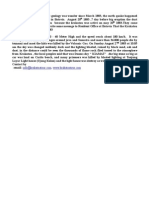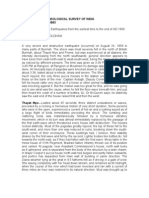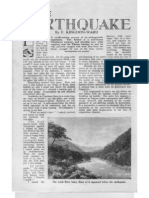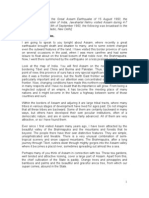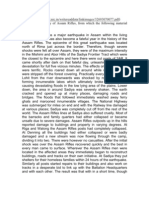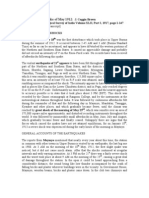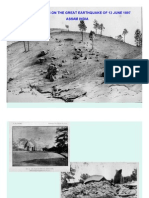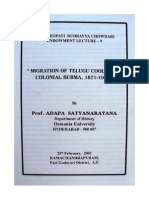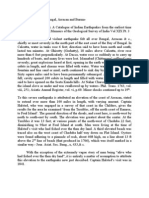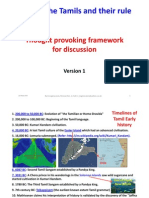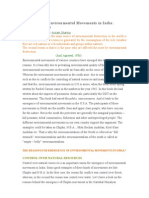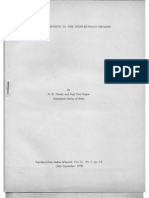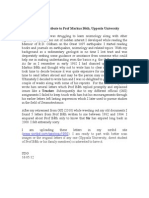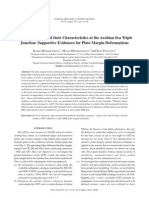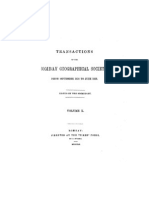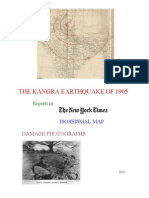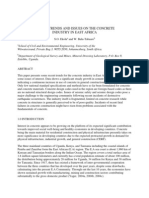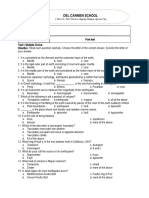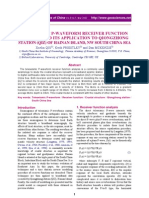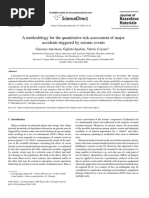1803 Earthquake in Garhwal Himalaya - Archival Materials With Commentary
1803 Earthquake in Garhwal Himalaya - Archival Materials With Commentary
Uploaded by
Sujit DasguptaCopyright:
Available Formats
1803 Earthquake in Garhwal Himalaya - Archival Materials With Commentary
1803 Earthquake in Garhwal Himalaya - Archival Materials With Commentary
Uploaded by
Sujit DasguptaOriginal Title
Copyright
Available Formats
Share this document
Did you find this document useful?
Is this content inappropriate?
Copyright:
Available Formats
1803 Earthquake in Garhwal Himalaya - Archival Materials With Commentary
1803 Earthquake in Garhwal Himalaya - Archival Materials With Commentary
Uploaded by
Sujit DasguptaCopyright:
Available Formats
Indian Journal of History of Science, 49.
1 (2014) 21-33
1803 EARTHQUAKE IN GARHWAL HIMALAYA ARCHIVAL MATERIALS WITH COMMENTARY
SUJIT DASGUPTA* AND BASAB MUKHOPADHYAY**
(Received 30 July 2013; revised 14 October 2013) Abstract Transcriptions from seven original documents describing the effects of the 1st September 1803 Garhwal earthquake constitute the basic theme of this paper. The objective is to collate all relevant materials and put it as a base document to facilitate future research. Descriptive accounts for this earthquake and contemporary research based on such sources indicate that this earthquake was a large event, if not major; and there is little reason to consider the epicenter to be located at Mathura or to suggest occurrence of two events between 00.30 and 01.30 hrs. Re-evaluation of archival materials further suggest that this earthquake might have produced aftershocks for fourteen years till the year 1817, followed by a lull period so far as seismicity is concerned in the Garhwal Himalaya up to 1831. Such a major earthquake within the so called central seismic gap in the Himalayas necessitates reconciliation on available seismic hazard assessment. Key words: Aftershock, Archival material, Central seismic gap, Himalaya, Seismic hazard, 1803 Garhwal Himalaya Earthquake.
1. INTRODUCTION
Evaluation of pre-instrumental and historic earthquakes is primarily based on published descriptive account of such events from a variety of documents. The original materials from which information on any earthquake retrieved are mostly travelogue, gazetteers, expedition accounts and various other documents that rarely and exclusively are dedicated to describing the earthquake. Careful extractions of signals relevant to earthquake, amongst noisy background materials are the primary task for any earthquake scientists desirous to bring forth the scientific essence and translate it into modern analogue for scientific pursuit. In the context of the Indian subcontinent, the first major earthquake of the nineteenth century was the 1st September 1803 Garhwal Himalaya earthquake, descriptions for which are available in published form in different journals and books. Based primarily on such rare and out-of-print documents, a number of research papers are published between 2003 and 2010. In the present paper, our objective is not to add another such downstream analysis but to bring together all such original materials as could be accessed for this earthquake and placed chronologically. This is necessary to make a comprehensive document with such commentaries for the benefit of planners, administrators, social scientists, historians as well as geographers for better appreciation of earthquake hazard; at the same time the document should be reference material for earthquake science professionals.
*Ex Geological Survey of India, Kolkata, India; email: sujitdasgupta@yahoo.com **Geological Survey of India, Central Headquarters, 27 J.L. Nehru Road, Kolkata-700016, India, email: basabmukhopadhyay@yahoo.com.
22
INDIAN JOURNAL OF HISTORY OF SCIENCE
Fig. 1. The 1st September 1803 Garhwal Himalaya Earthquake is felt from Punjab to Calcutta in India. The places from where reporting has been made, transcribed in the archived literature and referred in the text are plotted. Epicentral locations assigned for 1803 Garhwal Himalaya Earthquake by contemporary scientists (for details see Fig. 2 and text) are marked in red stars. Gray colour lines indicate location of major river network system in India.
The earthquake on the early morning of 1st September 1803 was felt over a large area of north and eastern India from Punjab to Calcutta (Fig. 1). At Calcutta, it was strong enough to throw water with fish from a water tank in the Botanic Garden. The earthquake damaged the upper part of Qutub Minar in Delhi and Imaumbarah in Lucknow. The earthquake was described as dreadful from Mathura with damage to many buildings. This was indeed a very large earthquake whose epicenter was located in the Garhwal Himalaya. At Barahat or Barahal (30.72oN: 78.48oE) (Uttarkashi) the earthquake laid great part of it in ruins, and killed 200 or 300 of the inhabitants, besides great numbers of cattle. Srinagar (30.18 N: 78.73 E) was turned in ruins. Considering the intensity that felt at Calcutta and its distance from the epicentral tract in Garhwal Himalaya; and the total area over which the earthquake was reported to be felt, the magnitude of the event is likely to be 7.5+ but possibly less than 8.0. The epicenter of the earthquake in all probability locates between the epicenters of Uttarkashi earthquake (19.10.1991; 30.77N: 78.79E; mb 6.4, Ms 6.9; h 15 km) of 1991 and Chamoli earthquake (29.03.1999; 30.51N: 79.42E; mb 6.3, Ms 6.6; h 20 km) of 1999, but close to the former (Fig. 2).
2. CONTEMPORARY RESEARCH
Quittmeyer and Jacob (1979) assigned intensity (MM) of VIII-IX at Mathura and VII-IX at Badrinath for the earthquake of 1803. From Marathi daily Kesari (of 26 January 1934), Athavale
1803 EARTHQUAKE IN GARHWAL HIMALAYA
23
Fig. 2. Snapshot of the source zone of 1803 Garhwal Himalaya Earthquake. Epicentral locations assigned by contemporary scientists are marked with red stars [1 - Ambraseys and Jackson (2003) M 7.5; 2 - Ambraseys and Douglas (2004) Mw 7.46; 3 - Bilham and Ambraseys (2005) Mw 8.1; 4 - Rajendran and Rajendran (2005) Mw 7.7; 5 - Martin and Szeliga (2010); 6 - Szeliga et al (2010) M 7.3]. Main Central Thrust (MCT) is marked with red line along with the important river systems referred in the text. Black stars indicate the epicentre of two recent devastating earthquake in the Garhwal Himalaya [Uttarkashi earthquake (19.10.1991; 30.77N: 78.79E; mb 6.4, Ms 6.9; h 15 km) of 1991 and Chamoli earthquake (29.03.1999; 30.51N: 79.42E; mb 6.3, Ms 6.6; h 20 km) of 1999]. Yellow colour zone indicates the extent of the Garhwal cluster defined by Mukhopadhyay et al. 2011.
(1995) records that this earthquake was felt at the same time at Kashi (Varanasi), Prayag (Allahabad) and Gaya. Besides, up above near Lord Vishnus abode Badrikedar, the city of Srinagar and in its neighbourhood earthquake occurred; land parted, about 500 to 1000 houses and mountain collapsed. Freymueller et al. (1996) assigned a magnitude of M7.70.2 for this earthquake. Ambraseys and Jackson (2003) made a detail study of the earthquake and gave an approximate location of 31.0N: 79.0E and magnitude 7.5. Ambraseys and Douglas (2004) further modified the location to 31.5N: 79.0E and magnitude Mw 7.46. Bilham and Ambraseys (2005) in their very next publication increased the magnitude to Mw 8.1 with epicenter at 31.5N: 79.0E. Rajendran and Rajendran (2005) presented detail analyses of the 1803 earthquake that includes an isoseismal map with maximum intensity of IXX in MSK scale around Srinagar- Devprayag; epicentral location is around 30.25N: 78.75E with assigned magnitude Mw 7.7. Epicentral location given by Martin and Szeliga (2010) is 30.7N: 78.8E. Szeliga et al (2010) assigned a magnitude of M 7.3 with epicentral location 30.656N: 78.784E (Fig. 2).
24
INDIAN JOURNAL OF HISTORY OF SCIENCE
3. COMMENTARY
3.1. Lawrence Dundas Campbell, 1806
FROM
ARCHIVES
In the Asiatic Annual Register of 1804 (published from London in 1806) there is reference to the earthquake of 1803; in page 35 of the chronicle (under the title Violent Earthquake) it is reported that on Thursday morning (1st September 1803), about half past one oclock, a smart shock of an earthquake was very distinctly felt in Calcutta, and its environs; the river was considerably agitated, and the water of a tank in the Botanic Garden was thrown over its banks, and many fish left in the gravel walk; the same happened to several other tanks in the neighbourhood of the town; and the church clock was stopped by the concussion, at about thirty-five minutes past one; the time was unfavorable to the observance of the continuance or direction of this awful phenomena, but it is probable we shall hear from other parts of the country the progress it took. In page 57 of the same Register there is another note from Mathura (27.50 N: 77.68 E) under the heading Dreadful Earthquake, states that on the night between the 31st August, and the 1st of September, at half an hour after midnight, a severe shock of an earthquake was felt at this place, which lasted for many minutes, and was violent beyond the memory of man. Probably not a living creature in the place, but was roused from his slumbers by the alarm, and felt its effects. Many of the Pucka buildings were cast down, and Zenanes, hitherto un assailed by violence, were deserted, and their fair inhabitants took refuge in the streets and in the fields, in dishabilles which had no effect to conceal, and in an affright which elevated their charms, seeking protection with men, whose visages it would otherwise have disgraced them to behold. The night was calm, and enjoyed the full influence of a bright moon; and when the alarm was over, the blushes and modesty of the fair deserters of their consecrated mansions, afforded a pleasing contrast to their previous distresses, and amply consoled their protectors for the desolation they had suffered in their own houses. Noorul Nissa Balgam, a beautiful and accomplished woman, then pregnant with her third child, was unfortunately killed by the falling of a tile, under which she had run for safety. In the morning very extensive fissures were observed in the fields, which had been caused by the percussion of the night before, through which water rose with great violence, and continues to run to the present date (24 September, 1803), though its violence has gradually abated. This has been a great benefit to the neighbouring Ryotts, as they were thence enabled to draw the water over their parched fields. The principal Mosque of the place, erected on an eminence by the famous Ghauze Khaun, has been shattered to pieces, and a considerable part of the dome was swallowed up during the opening of the earth*. The note further adds that several slighter shocks have since occurred, but it did not have occasioned any further damage. (* F.S. Growse in his book Mathura- A District Memoir adds to the actual damage of the mosque as: The gateway was cracked from top to bottom, the upper part of one of the minarets was thrown down and one little corner kiosques of the mosque was also destroyed, but the dome was uninjured).
3.2. George Viscount Valentia, 1811
Another notice to this earthquake of 1803 is given by Valentia (1811; page 159) when he was stationed at Meerun-ka-serai between Futty Ghur (27.37 N: 79.63 E; Fatehgarh in Farrukabad district, UP on the right bank of Ganga) and Mukhunpore. In the night he was alarmed by a violent motion of his bed, caused, as at the time supposed, by some animal having got under it; but on looking underneath, nothing was there. The motion was sufficiently violent to make him jump up in bed; nor could account
1803 EARTHQUAKE IN GARHWAL HIMALAYA
25
for it till morning, when the sepoy on guard at his tent said, that he had been thrown down by the motion of the earth, and almost every person had experienced the concussion: it could therefore be nothing but an earthquake. It moved, as nearly as he could conjecture, from N to S and lasted only a few seconds, at least that shock which he felt, and awoke. There might have been slighter shocks previously. The earthquake was felt from hence to Calcutta, but seems to have been most violent at Lucknow, where it destroyed the major part of the minarets, and cracked the Rome-kaderwasse (Roumi derwassah) and the Imaumbarah. Mr. Pauls building in the middle of his garden, in which Mr. Salt slept, has eight arched door-ways, and every one was cracked in the middle; the waters in the tanks overflowed with violence. At Allahabad it stopped the clock at seventeen minutes past one, but did no mischief. It is impossible to trace the progress of the shock, as there seems no difference in the time at Meerun-ka-serai, Lucknow, Allahabad, and Calcutta.
3.3. F. V. Raper, 1812
F.V. Raper surveyed from Hardwar (Haridwar) to Gangotri in 1808 in search of the source of the Ganges. A narrative of the survey was published in Asiatic Researches (Volume 11, 1812). On 23rd April, 1808 he entered the town of Barahat (latitude by observation 3043' 30" N) and described as (page 476 onwards): The town of Barahat (Uttarkashi 30.73N: 78.45E) by no means answered the expectation we had formed of it, being in extent and population, far inferior to many villages we had passed on the road. The houses, like those of all the villages in this part of the country, are built of large stones, with slated roofs; but none of them appear in a habitable state. One cause, however, of its present dismantled condition, proceeds from the injury it sustained from the earthquake of 1803, in which all the houses suffered materially, and some were completely buried in the ground. It is said, that two or three hundred people were killed by the falling in of the roofs; and that great numbers of cattle were destroyed on that fatal occasion. Few of the habitations have been rebuilt; and those that remain are so scattered and unconnected, that the place exhibits a striking picture of ruin and desolation. Barahat is the capital of a Talukah of the Rowain Perganah, and originally derived that name from its being the chief mart of twelve villages, which send here their goods for sale. Near the village is a curious Tril or trident, the base or pedestal of which is made of copper, in size and shape of a common earthen pot: the shaft is of brass, about twelve feet long, the two lower divisions decagonal, and the upper one spiral. The forks of the trident are about six feet in length. From each of the lateral branches, is a chain, to which bells were originally suspended.. It had formerly a temple erected over it, but in the earthquake of 1803, the mansion was thrown down, and, wonderful to relate, the pillar escaped without injury. But a large patched fracture in its side, a little staggered our faith as to its miraculous preservation. The town Deoaprayaga (Devprayag; 30.14N: 78.60E) was terribly shaken by the earthquake in 1803 (see page 491); many of the private houses, together with the terrace and cupola of the temple (Raghunath or Ramachandra), suffered material injury. This latter has been lately repaired by the hands of Brahmens, who were sent by Daulet Rao Sindea, under the inspection of his Guru or high priest, for the express purpose of restoring its dilapidations, as also those of Bhadrinatha, which is likewise under the superintendence of Brahmens, from the Dekhin, and was much injured by the same convulsion (The survey party was at Devprayag on 11 May 1808).
26
INDIAN JOURNAL OF HISTORY OF SCIENCE
By a mean of our observations, taken by Lieut. Webb, the town of Srinagar lies in latitude 301052N. It is situated on the S. bank of the Alacananda, in the centre of a valley, which is about four miles in length, running nearly in the direction of ENE to WSW and about two miles in its greatest breadth. The city extends along the banks of the river; the houses are in general two stories high constructed of large stones, with a shelving slated roof. When Col. Hardwicke visited this capital, in the year 1796, it was supposed to be in its most flourshing state but since that period many natural and fortuitous causes have combined to reduce it to a lower state of poverty and insignificance. The encroachments annually made by the Alacananda, the earthquake of 1803, which shook every building from its foundation and the Gurchali invasion at the close of the same year, formed such an accumulation of evils on this devoted capital, the city should not survive its native princes. Every house appears to have felt the shock: in the main street, not above one in five is inhabited; of some, the roofs have fallen in; of others the walls are rent asunder, and many lie a complete heap of ruins. The palace of the Raja is exactly in the same situation; some parts of it are entirely dismantled, and others in so tottering a condition, as to render it unsafe to pass under its walls. Many of the inhabitants, who attended us, expressed much sorrow at these events. [See pages 494-496; the survey party visited Srinagar on 13 May 1808]. Approaching Carna-prayaga on 22 May at about seven minutes past 3PM the survey party experienced a slight shock of an earthquake, which lasted for six or seven seconds, accompanied by a rumbling noise, like distant thunder We sought for refuge on the plain, where we waited for some time, in anxious expectation of the result. The temple of MAHADEVA stood a melancholy proof before us, having lost its cupola and roof, in the concussion of 1803. On 27 May the team marched towards Joshimath. It contains one hundred, or one hundred fifty houses, neatly built, of grey stone, and roofed with shingles.. To the right of it is a stone cistern, with two brazen spouts, whence water keeps constantly flowing into a basin below. It is constructed for the convenience of the towns people, and supplied by the stream from the mountain. Close to it, extending along another face of the square is a collection of temples, which bear the marks of great antiquity. They are raised on a terrace, about ten feet high, and in the centre of the area, stands the principal one, sacred to Vishnu. It is surrounded by a wall, about thirty feet square: at each angle, and in the centre of each face, are inferior temples, containing different deities. Several of them were destroyed, and thrown down by the earthquake; and most of them are in a very tottering condition. Those which suffered the least, and have the images perfect, are the temples of Vishnu, Ganesa, Surya or the sun, and the Naudevi. On 29 May marched towards Bhadri-Natha (Badrinath; 30.74N: 79.49E); on 30 May we passed the town and temple of Bhadri Natha, situated on the west bank of Alacananda, in the centre of a valley, about four miles in length, and one mile in its greatest breadth. The town is built on the sloping bank of the river, and contains only twenty or thirty huts and the temple, which occupies the upper part of the town. It is built in the form of a cone, with small cupola, surmounted by a square shelving roof, of plates of copper, over which is a golden ball and spire. The height of the building is not above forty or fifty feet. This divine architecture, was too weak to resist the shock of the earthquake, which left it in so tottering a condition, that human efforts were judged expedient, to preserve it from ruin (The survey party visited the temple on 31st May).
1803 EARTHQUAKE IN GARHWAL HIMALAYA
27
On the opposite side of Badrinath across Alacananda, is a large town, called Manah. Proceeding towards Manah in an hour and half we arrived at Calpa Gram. From the summit of this hill, a large stream called the Saraswati Nadi force a passage through a rocky cavern. The breadth of the cavity may be twenty five or thirty feet; and some large fragments, that have been thrown down by the earthquake, are collected, and wedged in together, at the mouth [See page 524-525].
3.4. J. A. Hodgson, 1822
In March- April 1817 Captain Hodgson traversed along the Jamuna valley from the junction of Tonse and Jamuna to Jamunotri through places Birat- Murlang- Cotha- Lakha Mandal- Bancauli- PauntiGira- Thanno- Catanaur- Pali- Ojha Ghur- Rana- Bannasa- Cursali. After passing the worst part of the route [beyond Thanno (latitude observed: 30 4912"), Catnaur (latitude observed: 30 5135") and a large village Pali along the Jumna valley] descended to Ojha Ghur (latitude observed 30 54' 47"), a hamlet of three huts only, at the feet of steep and lofty cliffs, the rocks hurled from which by the Earthquake of 1803, buried a small fort and village, which once stood here; dreadful mementos are seen in the mountains of that catastrophe. Under Ojha Ghur, a stream falls into the Jumna, and several cataracts are seen falling among the surrounding precipices. There are some hot springs at the bed of the Jumna, which is 400 feet below the hamlet. Captain Hodgson traversed along the upper reaches of the Ganges valley from Reital (observed lat: 30 48' 28"N) to Gangotri (observed lat: 30 59' 30"N) and beyond in May 1817. He did not specifically refer to any effects on account of the earthquake of 1803 along this part of his traverse but the survey party experienced a strong earthquake on the night of 26 May 1817 while camping at Gangotri. Account of this earthquake is as follows:
We lay down to rest; but between ten and eleven oclock were awakened by the rocking of the ground, and on running out we saw the effects of an earthquake, and the dreadful situation in which we were placed, in the midst of masses of rock, some of them more than 100 feet in diameter, and which had fallen from the cliffs above us, probably brought down by some former earthquake. The scene around us, shown in all its dangers by the bright moonlight, was indeed very awful. On the second shock, rocks were hurled in every direction from the peaks around to the bed of the river, with a hideous noise not to be described, and never to be forgotten. After the crash caused by the falls near us had ceased, we could still hear the terrible sounds of heavy falls in the more distant recesses of the mountains. We looked up with dismay at the cliffs overhead, expecting that the next shock would detach some ruins from them: had they fallen we could not have escaped, as the fragments from the summits would have tumbled over our heads, and we should have been buried by those from the middle. Providentially there were no more shocks that night. This earthquake was felt in all parts of the mountains, as well as in the plains of the north-west provinces of Hindostan. Providently there were no more shocks that night. This earthquake was smartly felt in all parts of the mountains, as well as in the plains of the NW provinces of Hindustan.. This day, the 27th we had a slight shock of an earthquake and so, on the 28th.
This earthquake of 26 May 1817 was also a moderately large event from the epicentral tract of that of 1803 as has been indicated from the presence of rock fall and slides that are reported by Hodgson. At Bhairoghati near the confluence of Bhagirathi and Jahnevi Rivers enormous blocks have fallen, some 200 feet diameter; earthquakes had rifted its lofty massy towers, spires and buttresses. On 30 May while traversing beyond Gangotri, Hodgson states: This station is full of peril; being a very recent slip of the whole face of the mountain to the leftthe broken summit cannot be less than 400 feet high; blocks threaten to fall and are indeed now continually coming down. The ruin extends about half a
28
INDIAN JOURNAL OF HISTORY OF SCIENCE
mile. The fracture of the rock is so fresh that I suspect this havoc must have been caused by the earthquake of 26th for we heard a great crash in this direction (see page 110). During his traverse on 31 May along snow covered area the author further mentions (see page 128): It is not easy to account for the deep rents which intersects this snow bedIt struck us that the late earthquakes might have occasioned some of the rents. Additional observation by Captain Hodgson through letters on this earthquake, as quoted by Baird-Smith (1843) is as follows:
The Earthquake at Gungoutri (Gangotri) was by far the most alarming phenomenon of nature I ever witnessed, and the frequent, almost daily, recurrence of the shocks, though slight, made us uneasy, as it showed that there was some active agent at work perhaps under our feet, which might at any instant bring down the cliffs beneath which we scrambled along on our The range of this shock appears to have been the same as that of 1803, and its intensity could scarcely have been much inferior. No counts, however, of any destructive effects on the towns in the Himalayas, have come under my notice, although from the vicinity of some of them to Gungoutri, they could hardly have escaped the effects of the vibrations and the land-slips caused by them. The dislodgement of a mass of rock 4,000 feet in height and half a mile in length gives an appalling idea of the intensity of the disturbing force, while it proves how very probable it is, that many of those sudden depressions and elevations of rivers having their sources in mountains liable to such convulsions, are caused by land-slips of this nature. Captain Hodgson alludes to numerous other enormous slips observed after the Earthquake, and to many he assigns the same origin as to that above-mentioned, while others appeared older, and due either to previous convulsions or to the disintegrating effects of atmospheric agents.
3.5. R. Baird-Smith (1843)
Unlike the four documents given above that recorded primary and firsthand accounts for the earthquake of 1803, though none of them dedicated for describing earthquakes, the present entry from Baird-Smith (1843) is the first reference account to give historical summary of Indian earthquake. Accordingly Baird-Smith (1843) has extensively reproduced materials that are already documented in the previous references; in spite of some duplication we reproduce the narration by Baird-Smith (1843) and also his comments on this earthquake. An exhaustive account on this 1803 earthquake was compiled by Baird-Smith (1843). He states that this is the first Earthquake emanating from the central portion of the Himalaya range, of which any authentic information has been obtained. Its destructive effects were chiefly experienced in the mountain provinces of Sirmoor, Gurwhal and Kumaon, although its influence is said to have extended throughout the whole of the plains of Hindustan, from the Himalayas to Bengal. Summarized description from that given by Colonel Hodgson, late Surveyor General of India which appeared in Gleanings of Science (vol. II, p. 50) and Asiatic Researches, (vol. XIV, p. 139: Survey of the Rivers Ganges and Jumna; dated 13 April 1817) and quoted by Baird-Smith (1843) are as follows:
The Earthquake of 1803, which was considered violent in this country, and many buildings were damaged over the whole extent from Bengal to the Punjaub; but in the mountains its effects were terrible, and a great part of the population perished; whole villages having been buried by the fall of cliffs, and sliding down of the faces of the hills. After passing the worst part descended to Ojha Ghur a hamlet of three huts only, at the feet of steep and lofty cliffs, the rocks hurled from which by the Earthquake of 1803, buried a small fort and village, which once stood here; dreadful mementos are seen in the mountains of that catastrophe. Under Ojha Ghur, a stream falls into the Jumna, and several cataracts are seen falling among the surrounding precipices. There are some hot springs at the bed of the Jumna, which is 400 feet below the hamlet.
1803 EARTHQUAKE IN GARHWAL HIMALAYA
29
The city of Sreenuggur, the capital of the mountain province of Gurhwal, suffered severely from the same shock. James Eraser, Esq. in his Tour in the Himalayas (p. 369,) thus alludes to the circumstance:
Sreenuggur (Srinagar; 30.22 N: 78.78 E; presently in Pauri Garhwal district, Uttrakhand), the chief town or capital of Gurhwal, is situated on the south bank of the Alacnanda, about twenty miles above its junction with the Bhagiruttee at Deopragur (Devprayag; 30.14 N: 78.60 E in Tehri Garhwal district, Uttrakhand where Alakananda and Bhagirathi meets to make Ganga), where a strip of level ground stretches along for three or four miles, forming the valley known by the same name as the town. It was once comparatively populous and prosperous, forming as it did, not only the residence of the court, but a considerable enterpt for the produce of the various countries in and on either side of the snowy mountains, which exchange commodities by the Nitteemana and other Passes. When Colonel Hardwicke visited this place in 1796, it was perhaps not in its prime, but contained (as he computed) 700 or 800 houses and a good bazar. When Messrs. Webb and Raper, in 1808, passed through it on their way to Buddreenauth, it had sunk deeply in importance, and was to all appearance rapidly advancing to decay. It had not only to contend with the common enemies of the country, but also with natural causes no less ruinous. An Earthquake had occurred in 1803, which had done considerable injury: many houses were ruined, and the Rajahs palace was particularly shattered; and the encroachments of the river Alacnanda yearly destroy a portion of that which yet stands, threatening in time to sap the foundations of all.
Buddreenauth (Badrinath; 30.74 N: 79.49 E), the celebrated resort of Hindoo pilgrims, situated near the sources of the Alacnanda River, one of the tributaries of the Ganges, did not escape the destructive effects of the Earthquake of 1803. After describing the principal temple at this holy spot, Captains Webb and Raper continue thus:
The era of its foundation is too remote to have reached as, even by tradition; but it is considered the work of some superior being. This specimen of divine architecture, however, was too weak to resist the shock of the Earthquake, which left it in so tottering a condition, that human efforts were judged expedient to preserve it from ruin : and the repairs which it has lately undergone, have completely modernized its external appearance. The body of it is constructed of large flat stones, over which is a coat of fine white plaster, which adds to the neatness, but has destroyed all outward pretensions to antiquity.
The large town of Barahat (Uttarkashi) on the Bhagiruttee River, also a favourite resort for pilgrims, is the only other place in this neighbourhood which is specifically mentioned as having been injured by the Earthquake under notice. All its temples were more or less shattered, and many of its houses ruined, so that when visited by Mr. Fraser in 1815, it presented a miserable spectacle of dilapidation and filth. Before this catastrophe, it is said to have had fifty or sixty shops with a well frequented bazaar and numerous shrines and temples; after it, a few mud hats with the ruin of former buildings alone remained. Baird-Smith (1843) further states that he has not been able to obtain any specific information relative to the ravages of the Earthquake in Kumaon, beyond the fact, that they were not less severe there than in Gurhwal, involving the destruction of life and property to a great extent. The information obtained is not sufficiently precise to warrant any attempt being made to define the extreme limits of the shock of 1803, nor to trace it to any special spot as its focus of emanation. According to Captain Hodgsons statement, it injured buildings throughout the whole plains of Hindoostan, and if so, it must have been one of the severest shocks ever experienced in this country. Its fearfully increased intensity in the mountains shows very distinctly that it was in them it had its source, and I have therefore had no hesitation in assigning it to the Central Himalayan tract. It can only however be thus referred in general terms, since to do more would require details much more minute and specific than, from the nature of the case, it is practicable to collect.
30
INDIAN JOURNAL OF HISTORY OF SCIENCE
3.6. Leopold Von Orlish (1845)
Captain Leopold Von Orlish (1845) in his book Travels in India, described Coottub Minar along with its damage sustained by the 1803 earthquake. This German document was translated by H. Evans Lloyd wherein it is stated (see page 28) .
The lofty Coottub Minar: it is built of very fine, hard red sandstone, is 62 feet in diameter at the base, and rises to the height of 265 feet; it is divided into three stories, and the upper gallery is elevated 242 feet 6 inches above the ground. This column, which is the highest in the world, was intended by Coottub-udDeen to mark the entrance to a mosque which he purposed building. The lower story is about 90 feet high, and is built in alternate angular and concave channelings, on which sentences from the Koran are inscribed in raised Arabic characters; the other two stories consist of concave flutings only, and diminish gradually to the summit. The whole is crowned by a small dome, which is supported by eight square pillars: this dome was shattered by an earthquake in the year 1803, but has been restored by the English in its original form.
3.7. Thomas Oldham (1883)
Thomas Oldham (1883) in his catalogue of Indian earthquakes mentions the event with information already provided in the previous documents; nevertheless as this reference always features in contemporary research, materials printed in the catalogue for the 1803 earthquake is reproduced in next paragraphs.
1st September, 1803, 00.30 Midnight; Matura (Muttra) : the shock was very violent; lasted several minutes. Many pucka buildings were thrown down; very extensive fissures in fields, through which water rose with considerable violence, and in quantity sufficient to be used by cultivators. Principal mosques, erected by Ghazi Khan, destroyed, and a considerable part of the dome was swallowed up during the opening of the earth. Several slighter shocks followed. Calcutta: The same was felt at Calcutta and neighbourhood; river much agitated; water, with many fish, thrown out of tanks; church clock stopped at 01.35 night. Kumaon?: The earthquake, given as occurring in this year without date in Kumaon, where many buildings were ruined, was most probably the same. Upper Valleys of Ganges, Sirmoor and Gurhwal: Very violent; 200-300 people destroyed at Barahal. Badrinath also suffered severely; several villages swallowed up.
Historian Dr. Elphinstone states that the Qutb Minar at Delhi was deprived of its upper portion by an earthquake. No authority is given, and I have searched in vain for any detailed record. I have been able, by the friendly aid of Maulavi Kabiruddin, to find in a modern work entitled Asar-u-Sanadid by Sewad-ud- dowlah, printed in Delhi in 1847, a passing NOTICE of this fact. But this merely records that Sultan Sikandar, son of Beloli, had the upper portion of the Qutb renewed after it had been injured by lightning, and that subsequently it was again injured by lightning and an earthquake, after which it was repaired by the English. No date is given, or interval after the repairs by Sikandar. General Cuningham states that this injury of the Qutb Minar happened on the 1st August 1803, but he gives no authority. There can be little doubt that it was the result of the earthquake here noticed. And the authorities quoted are clear as to its having been on the 1st of September, not August.
4. DISCUSSION
In compiling this commentary on the earthquake of 1st September 1803, quite a number of publications in English language published during first half of the nineteenth century have been consulted.
1803 EARTHQUAKE IN GARHWAL HIMALAYA
31
The observation is that after the publication of Baird-Smith (1843), subsequent reference to this earthquake in published documents are derivatives from earlier sources and do not add to any new information. Thus commentaries from seven documents albeit with some repetitions are given here. However we are not aware of any published or unpublished documents in local language that may have been written from localities that suffered massive damages. At the beginning we have summarized the results of contemporary research on this earthquake and do not intend to enter into critical analysis of the documented observations on the timings or effects of the earthquake at various sites, due to reasons of partial and incomplete reporting of such early nineteenth century earthquake from India. Nevertheless as a direction to further research two points are highlighted below. (i) Both Chandra (1977) and Bapat (1983) considered Mathura as the epicenter of the earthquake based on reported damage from the said site, following Oldham (1883), and apparently not taking into considerations other severe damage reports from the Garhwal Himalaya. Mathura being an alluvial site damage was amplified and also being a populous site even during 1803 with the introduction of the British (Company) to Mathura early that year, damage reports got highlighted for the site. From the macroseismic epicentral location in Garwhal Himalaya, distance to Mathura is around 400 km; had Mathura been the epicenter of a 7.0+ magnitude earthquake the site would have been totally devastated. Hundred years latter Mathura was no longer an important location and there is only a brief reference to Mathura district (Middlemiss, 1910) for the 1905 Kangra earthquake (650 km from the epicenter) indicating only distinct shaking and rumor that some houses fell in the city (Kosi). It may further be noted that intensity of damage at Mathura due to the Garhwal earthquake of 1803 (epicentral distance ~ 400 km) is ~VII in MSK scale (Rajendran and Rajendran, 2005); similar damage intensity (VI-VII; see Dasgupta and Acharyya, 2006) was experienced at Calcutta due to the 1934 Bihar-Nepal earthquake, the epicentral distance being ~ 500 km but at the same time the magnitude of the latter was higher than that of the former. (ii) Some authorities (pers. comm.) refer to the timings of the earthquake as mentioned by Oldham as 00.30 hrs at Mathura and 01.35 hrs at Calcutta to probe the possibility of two shocks; Oldhams numerical transcription of time was based on the report of Campbell (1806) where it was stated that at Mathura, the earthquake was felt at half hour after mid night. To translate this phrase to 00.30 hrs is grossly an oversimplification particularly when we note more specific mention of time from Allahabad where the watch was stopped at 17 minutes past one (Valentia, 1811); similarly the watch was stopped at 01.35 hrs at Calcutta (Campbell, 1806). Considering different time keeping standards during nineteenth century viz. Calcutta and Madras time (even during early twentieth century Western India followed Madras time) and errors in time keeping we may logically consider it to be single event that occurred between 01.00 and 01.30 hrs at midnight. Re-evaluation of archival materials indicated that after the large earthquake of 1st September 1803, Raper (1812; see above) experienced an earthquake on 22nd May 1808 while he was at Karnapryag; referring to H. Falconer (1841; p. 618), Baird-Smith (1843) further added an earthquake from the region in 1809..An event of this sort is not improbable, for we know that in 1809, an earthquake of such force took place in Gurhwal, that the Bishnoo-Gunga river, one of the great branches of the Ganges, was blocked up below Goseenauth by a landslip, and the water rose to 40 feet above its usual level. Further Hodgson (1822; see above) recorded earthquakes on 26- 28 May 1817 while at Gangotri.
32
INDIAN JOURNAL OF HISTORY OF SCIENCE
Two significant observations recorded by Baird-Smith (1843) is that (i) between the years 1817 to 1831 there is no record of any earthquake (page 1035-1037) from the central Himalaya and (ii) fifty five earthquakes have been experienced in the interior of the Himalayas since 1803. Leaving nine recorded events that occurred after 1831 till 1842 and no records between 1817 and 1831, the remaining 46 earthquakes should have occurred between 1803 and 1817. If there were so many earthquakes in the Garhwal Himalaya at regular intervals since the large earthquake of 1803 till 1817 followed by a lull period up to 1831, a possible explanation could be that aftershock sequence for the 1803 earthquake continued for ~ 14 years and in that case the 1803 earthquake could have been a major event beyond the psychological barrier of magnitude 7.9. It may be noted that the 1803 earthquake locates in the Garhwal cluster (see Fig. 2) that is capable of generating earthquake with maximum magnitude of the order of 8.25 and average displacement of 7.78m (Mukhopadhyay et al, 2011).
5. ACKNOWLEDGEMENT
We have extensively used the website Google Books for consulting almost all archive materials. Constructive comments and interest shown by the Editors and learned reviewer have considerably improved the scientific content of the paper.
REFERENCES
1. 2. 3. 4. 5. 6. 7. 8. Ambraseys, N. & Jackson, D. A note on early earthquakes in northern India and southern Tibet. Current Science, 84 (4) (2003): 570- 582 Ambraseys, N. & Douglas, J. Magnitude calibration of north Indian earthquakes. Geophysics Journal International 159 (2004):165-206 Athavale, R N. Two undocumented historic earthquakes and additional information on the major earthquake of 1 September 1803 from north India. Current Science 69(3) (1995): 279- 280. Bapat, A., Kulkarni, R C. & Guha, S K. Catalogue of earthquakes in India and neighbourhood from historical period upto 1979. ISET, Roorkee (1983):1-211. Bilham, R, & Ambraseys, N. Apparent Himalayan slip deficit from summation of seismic moments for Himalayan earthquakes 1500- 2000. Current Science 88 (10) (2005):1658- 1663 Campbell, L D. The Asiatic Annual Register for the Year 1804. (1806) pages 35 and 57. Chandra, U. Earthquakes of Peninsular India- A seismotectonic study. Bulletin of Seismic Society of America 67(5) (1977):1387-1413. Dasgupta, S & Acharyya, A. Seismic hazard assessment and microzonation: approach for greater Kolkata urban agglomeration, Interactive Meet on Seismic Microzonation, 11-12 October, Geological Survey of India, Lucknow (2006). Falconer, H. Letter to the Secretary of the Asiatic Society on the recent Cataclysm of the Indus. Journal of the Asiatic Society of Bengal 10 (Part 2) (1841):615-620.
9.
10. Freymueller, J, Bilham, R, Brgmann, R, Larson, K M., Pal, J, Jade, S & Gaur, V K. Global Positioning System measurements of Indian Plate Motion and convergence across the lesser Himalaya. Geophyscs Research Letter 23 (1996): 3107 3110. 11. Hodgson, J A. Journal of a Survey to the Heads of the Rivers Ganges and Jumna. Asiatick Researches 14 (1822):60152.
1803 EARTHQUAKE IN GARHWAL HIMALAYA
33
12. Lloyd, E H. Travels in India, Vol. II, London 1845 (translated from original German by Captain Leopold Von Orlish). 13. Martin, S & Szeliga, W. A Catalogue of Felt Intensity Data for 570 Earthquakes in India from 1636 to 2009. Bulletin of the Seismological Society of America 100(2) (2010):562569, doi: 10.1785/0120080328. 14. Middlemiss, C S. The Kangra earthquake of 4th April 1905. Memoirs of Geological Survey of India 38 (1910):1-409. 15. 16. Mukhopadhyay, B, Acharyya, A & Dasgupta, S. Potential Source Zones for Himalayan Earthquakes: Constraints from Spatial- Temporal Clusters. Natural Hazards 57 (2011): 369- 383. Oldham, T. A Catalogue of Indian Earthquakes from the earliest time to the end of AD 1869. Memoirs of the Geological Survey of India 19 Part 3 (1883).
17. Quittmeyer, R C & Jacob, K H. Historical and Modern Seismicity of Pakistan, Afghanistan, Northwester India, and Southeastern Iran. Bulletin of the Seismological Society of America 69(3) (1979): 773-823. 18. Rajendran, C P & Rajendran, K. The Status of Central Seismic Gap: A perspective based on spatial and temporal aspects of large Himalayan Earthquakes. Tectonophysics 395 (2005): 19-39 19. Raper, F V. Narrative of a Survey for the purpose of discovering the sources of Ganges, Asiatic Researches 11 (1812): 446- 563 20. Baird-Smith, R. Memoir on Indian Earthquakes. Journal of the Asiatic Society of Bengal 12 Part II New Series No. 144 (1843):1029-1056. 21. Szeliga, W, Hough, S, Martin, S & Bilham, R. Intensity, Magnitude, Location, and Attenuation in India for Felt Earthquakes since 1762. Bulletin of the Seismological Society of America 100.2 (2010) 570-584; doi: 10.1785/ 0120080329. 22. Valentia, G V., Voyages and Travels to India, Ceylon, the Red Sea, Abyssina and Egypt in the years 1802- 1806, Volume 1 (India- Ceylon) (1811).
You might also like
- Assam HistroyDocument11 pagesAssam HistroyRakesh SarkarNo ratings yet
- Bengal Earthquake of 14 July1885Document19 pagesBengal Earthquake of 14 July1885Sujit DasguptaNo ratings yet
- KrakatauDocument1 pageKrakatauangga1976No ratings yet
- Caves of MeghalayaDocument5 pagesCaves of MeghalayaPushpa B SridharanNo ratings yet
- 24 August 1858 Pyay (Prome) Burma EarthquakeDocument5 pages24 August 1858 Pyay (Prome) Burma EarthquakeSujit DasguptaNo ratings yet
- The Gangetic Delta - in The Calcutta Review 1859Document22 pagesThe Gangetic Delta - in The Calcutta Review 1859Sujit DasguptaNo ratings yet
- Kak - The Mahabharata and The Sindhu-Sarasvati TraditionDocument13 pagesKak - The Mahabharata and The Sindhu-Sarasvati TraditionTensing RodriguesNo ratings yet
- The Armenians and Greeks of CalcuttaDocument8 pagesThe Armenians and Greeks of CalcuttaSujit DasguptaNo ratings yet
- Kingdon Ward On 1950 Assam EarthquakeDocument5 pagesKingdon Ward On 1950 Assam EarthquakeSujit Dasgupta100% (1)
- October 1943 Assam EarthquakeDocument7 pagesOctober 1943 Assam EarthquakeSujit DasguptaNo ratings yet
- 1950 Assam EQ-AIR Nehru SpeechDocument4 pages1950 Assam EQ-AIR Nehru SpeechSujit DasguptaNo ratings yet
- An Overview of The Siwalik AcheulianDocument12 pagesAn Overview of The Siwalik AcheulianSuman DasNo ratings yet
- Descriptive Account of 1950 Assam EarthquakeDocument12 pagesDescriptive Account of 1950 Assam EarthquakeSujit Dasgupta100% (2)
- Siwalik Range, Also Called Siwalik Hills or Outer Himalayas, Siwalik Also Spelled Shiwalik, SubDocument27 pagesSiwalik Range, Also Called Siwalik Hills or Outer Himalayas, Siwalik Also Spelled Shiwalik, Subamita guptaNo ratings yet
- J7 HISTORY Ancient Tamil CivilizationDocument12 pagesJ7 HISTORY Ancient Tamil Civilizationchitra selviNo ratings yet
- Syntaxis of AssamDocument14 pagesSyntaxis of AssamTushar TodkarNo ratings yet
- The Portuguese of CalcuttaDocument5 pagesThe Portuguese of CalcuttaSujit DasguptaNo ratings yet
- Kerala Geomorphology and LandslideDocument16 pagesKerala Geomorphology and Landslidejeysara_j1No ratings yet
- Burma Earthquake of May 1912Document16 pagesBurma Earthquake of May 1912Sujit Dasgupta100% (1)
- Panipat HistoryDocument39 pagesPanipat HistoryAwais JuttNo ratings yet
- Ancient PuruliaDocument14 pagesAncient PuruliaShivam PanjtaniNo ratings yet
- Bibliography On The Butterflies and Odonates of THDocument9 pagesBibliography On The Butterflies and Odonates of THpoojakala23468No ratings yet
- Geology of India and Burma by M S Krishnan PDFDocument573 pagesGeology of India and Burma by M S Krishnan PDFEon CreativeNo ratings yet
- .A Brief History of Water Supply in Antiquity PDFDocument12 pages.A Brief History of Water Supply in Antiquity PDFtoza vitaminozaNo ratings yet
- 36 IGC Coffee Table Book CompressedDocument269 pages36 IGC Coffee Table Book Compressedgeoheritage.sbicaps100% (1)
- South Indian Mercantile Communities in Ceylon - IndrapalaDocument19 pagesSouth Indian Mercantile Communities in Ceylon - IndrapalaSwaminathan ShankarNo ratings yet
- Chapter-1 Proto-History Refers To A Period Between Pre-History and History. It Is GenerallyDocument12 pagesChapter-1 Proto-History Refers To A Period Between Pre-History and History. It Is Generallyalisyed37No ratings yet
- Chapter 2: The Study AreaDocument30 pagesChapter 2: The Study AreaNissam SidheeqNo ratings yet
- Photographs On The Great Assam (Shillong) Earthquake of 12 June 1897Document33 pagesPhotographs On The Great Assam (Shillong) Earthquake of 12 June 1897Sujit DasguptaNo ratings yet
- Indian Archaeology 1996-97 PDFDocument168 pagesIndian Archaeology 1996-97 PDFATHMANATHANNo ratings yet
- Migration of Telugu Coolies To Colonial Burma, 1871-1947 - Prof. Adapa SatyanarayanaDocument18 pagesMigration of Telugu Coolies To Colonial Burma, 1871-1947 - Prof. Adapa Satyanarayanakkkotha2366100% (1)
- Physical Division of West BengalDocument3 pagesPhysical Division of West BengalViru SehwagNo ratings yet
- Burzahom Burzohama A Neolithic Site in KashmirDocument4 pagesBurzahom Burzohama A Neolithic Site in KashmirEditor IJTSRDNo ratings yet
- Provincialseries00mirzuoft PDFDocument356 pagesProvincialseries00mirzuoft PDFjerryjackson ali0% (1)
- EarlyandhraDocument29 pagesEarlyandhrashesh_kgNo ratings yet
- Myanmar (Burma) Pegu Earthquake of May 5 1930Document17 pagesMyanmar (Burma) Pegu Earthquake of May 5 1930Sujit Dasgupta100% (1)
- Guru PeriodDocument28 pagesGuru Periodpcbranch.copNo ratings yet
- DC Bulletin 72-73 PDFDocument528 pagesDC Bulletin 72-73 PDFAnindya BandyopadhyayNo ratings yet
- Basics of Archaeological AnthropologyDocument37 pagesBasics of Archaeological AnthropologyUsha HorapetiNo ratings yet
- Historical Chronology of Jammu and Kashmir StateDocument92 pagesHistorical Chronology of Jammu and Kashmir StateVikas GautamNo ratings yet
- Id 239 Assessment+of+B-VII-III+pay+within+Middle+Bhuban+Formation+in+Baramura+Anticline,+Tripura +Implications+of+Structural+Modeling+and+Sand+Connectivity+on+Exploration+and+Development+Document6 pagesId 239 Assessment+of+B-VII-III+pay+within+Middle+Bhuban+Formation+in+Baramura+Anticline,+Tripura +Implications+of+Structural+Modeling+and+Sand+Connectivity+on+Exploration+and+Development+Bulu DasNo ratings yet
- Wild Edible Fruits of Arunachal PradeshDocument7 pagesWild Edible Fruits of Arunachal Pradeshayam Victor SinghNo ratings yet
- GSI Western Region StatesDocument4 pagesGSI Western Region StatesajitnirmalNo ratings yet
- Magadha - WikipediaDocument26 pagesMagadha - WikipediaRenu AgarwalNo ratings yet
- 06 - Chapter 1Document10 pages06 - Chapter 1Loke RajpavanNo ratings yet
- TelanganaDocument19 pagesTelanganaRupesh Chennuri100% (1)
- Geography Notes 2Document52 pagesGeography Notes 2ayan mitraNo ratings yet
- Bay of Bengal Earthquake of 1762Document24 pagesBay of Bengal Earthquake of 1762Sujit DasguptaNo ratings yet
- Land of Tamils Loges War AnDocument35 pagesLand of Tamils Loges War Anwalter2099175No ratings yet
- Emergence of Environmental Movements in IndiaDocument6 pagesEmergence of Environmental Movements in IndiaYash ShahNo ratings yet
- History of PunjabDocument2 pagesHistory of PunjabKRiti ChouhanNo ratings yet
- Water-Related Architecture As An Identity Anchor of Chanderi-Madhya Pradesh, IndiaDocument4 pagesWater-Related Architecture As An Identity Anchor of Chanderi-Madhya Pradesh, IndiaBONFRINGNo ratings yet
- December 1967 Koyna Earthquake Damage PhotographsDocument20 pagesDecember 1967 Koyna Earthquake Damage PhotographsSujit DasguptaNo ratings yet
- Economy in Gupta PeriodDocument2 pagesEconomy in Gupta PeriodEkansh DwivediNo ratings yet
- Drought Assessment KSNDMCDocument117 pagesDrought Assessment KSNDMCpandurang HNo ratings yet
- Archaeometallurgy in IndiaDocument5 pagesArchaeometallurgy in IndiaSuneel KotteNo ratings yet
- Devangana Desai Felicitation Volume - AulikarasDocument12 pagesDevangana Desai Felicitation Volume - AulikarasKondaa S.SenthilKumarNo ratings yet
- Agarwal, S. C., Stout, S. D. (2003) - Bone Loss and Osteoporosis. An Anthropological Perspective. Springer PDFDocument250 pagesAgarwal, S. C., Stout, S. D. (2003) - Bone Loss and Osteoporosis. An Anthropological Perspective. Springer PDFAggelos TrontzosNo ratings yet
- Mundane Astrology Natural Calamities EarthQuakesDocument3 pagesMundane Astrology Natural Calamities EarthQuakesRakeshVadekarNo ratings yet
- Revisiting Two Indian Earthquakes of 1885Document6 pagesRevisiting Two Indian Earthquakes of 1885Sujit DasguptaNo ratings yet
- List of Publications - Sujit Dasgupta GSIDocument6 pagesList of Publications - Sujit Dasgupta GSISujit DasguptaNo ratings yet
- Earthquake Landslide Flood Cycle - Flood in Brahmaputra IndiaDocument14 pagesEarthquake Landslide Flood Cycle - Flood in Brahmaputra IndiaSujit DasguptaNo ratings yet
- Revisiting Two Indian Earthquakes of 1885Document6 pagesRevisiting Two Indian Earthquakes of 1885Sujit DasguptaNo ratings yet
- Environment of KolkataDocument2 pagesEnvironment of KolkataSujit DasguptaNo ratings yet
- List of Publications - Sujit Dasgupta GSIDocument6 pagesList of Publications - Sujit Dasgupta GSISujit DasguptaNo ratings yet
- Dutch Cemetery Cossimbazar, Murshidabad, West Bengal, IndiaDocument7 pagesDutch Cemetery Cossimbazar, Murshidabad, West Bengal, IndiaSujit DasguptaNo ratings yet
- Sumatra-Andaman Earthquake and Tsunami 26 December 2004Document253 pagesSumatra-Andaman Earthquake and Tsunami 26 December 2004Sujit DasguptaNo ratings yet
- Tectono-Geology Map Northeast India and Adjacent MyanmarDocument1 pageTectono-Geology Map Northeast India and Adjacent MyanmarSujit Dasgupta100% (2)
- Genesis of A New Slab Tear Fault in The Indo-Australian Plate, Offshore Northern Sumatra, Indian Ocean.Document8 pagesGenesis of A New Slab Tear Fault in The Indo-Australian Plate, Offshore Northern Sumatra, Indian Ocean.Basab MukhopadhyayNo ratings yet
- The Portuguese of CalcuttaDocument5 pagesThe Portuguese of CalcuttaSujit DasguptaNo ratings yet
- Biodata Sujit Dasgupta, 2014Document1 pageBiodata Sujit Dasgupta, 2014Sujit DasguptaNo ratings yet
- Limestone in The Indo-Burman (Myanmar) RangeDocument13 pagesLimestone in The Indo-Burman (Myanmar) RangeSujit DasguptaNo ratings yet
- Calcutta, Job Charnock and The ST John's ChurchDocument20 pagesCalcutta, Job Charnock and The ST John's ChurchSujit DasguptaNo ratings yet
- Tribute To Prof Markus BåthDocument6 pagesTribute To Prof Markus BåthSujit DasguptaNo ratings yet
- Arabian Sea Triple JunctionDocument16 pagesArabian Sea Triple JunctionSujit DasguptaNo ratings yet
- Bengal and The Ganges in 1757Document10 pagesBengal and The Ganges in 1757Sujit DasguptaNo ratings yet
- 24 January 1852 Upper Scinde Murree EarthquakeDocument4 pages24 January 1852 Upper Scinde Murree EarthquakeSujit DasguptaNo ratings yet
- Kangra Earthquake 1905: New York Times Report, Isoseismal Map, Damage PhotographsDocument27 pagesKangra Earthquake 1905: New York Times Report, Isoseismal Map, Damage PhotographsSujit DasguptaNo ratings yet
- Fossils From Surma Basin 1982Document9 pagesFossils From Surma Basin 1982Sujit DasguptaNo ratings yet
- Hydrodynamic Effects During Earthquakes On Dams and Retaining WallsDocument6 pagesHydrodynamic Effects During Earthquakes On Dams and Retaining WallsAndres CaroNo ratings yet
- Describing MotionDocument77 pagesDescribing MotionNanetteNo ratings yet
- Haiti Earthquake Thesis StatementDocument8 pagesHaiti Earthquake Thesis Statementmichellespragueplano100% (2)
- Natural: DisastersDocument68 pagesNatural: Disastersali.mosaad1996No ratings yet
- How To Conduct Eq DrillDocument28 pagesHow To Conduct Eq DrillMdrrmo Roxas IsabelaNo ratings yet
- Science 8 q2Document35 pagesScience 8 q2MARIE CARMEL MICOMPALNo ratings yet
- From CP 114 To BS8110 EssayDocument10 pagesFrom CP 114 To BS8110 EssayAlan CheungNo ratings yet
- Dynamic PDFDocument273 pagesDynamic PDFakash pandeyNo ratings yet
- Year 9 Science Space and Geology RevisionDocument5 pagesYear 9 Science Space and Geology Revisiondan964No ratings yet
- Plate Tectonics Week 1Document56 pagesPlate Tectonics Week 1liza rimpaNo ratings yet
- Earthquakes: Class 9 - Total Geography Morning StarDocument7 pagesEarthquakes: Class 9 - Total Geography Morning StarLEKHRAJ YADAV K MNo ratings yet
- Risk Assessment Tank FarmDocument57 pagesRisk Assessment Tank FarmAwolayeofori TamunosakiNo ratings yet
- DRRM Narrative ReportDocument6 pagesDRRM Narrative ReportnutmegNo ratings yet
- Calculation of Wind Loads On Rooftop Equipment Per ASCE7-10Document13 pagesCalculation of Wind Loads On Rooftop Equipment Per ASCE7-10RicardoNo ratings yet
- Theme 2 - SecciaDocument18 pagesTheme 2 - SecciaSofia GrigoriadisNo ratings yet
- B2 UNIT 8 Test StandardDocument6 pagesB2 UNIT 8 Test StandardAlondra MelNo ratings yet
- Post Test For Science 10Document4 pagesPost Test For Science 10Gerry EstillerNo ratings yet
- QiuPM2002 JGCDocument8 pagesQiuPM2002 JGCManichandra SanoujamNo ratings yet
- Negros Occidental Grade 10 - Jade Science First July 8, 2019 1 HourDocument2 pagesNegros Occidental Grade 10 - Jade Science First July 8, 2019 1 HourxoxkakidoxoxNo ratings yet
- Cozzani Et Al 2007Document12 pagesCozzani Et Al 2007vincio89No ratings yet
- Detailed Lesson Plan 2Document12 pagesDetailed Lesson Plan 2Rosenda CorralNo ratings yet
- Bahasa Inggris XII GanjilDocument8 pagesBahasa Inggris XII Ganjilhusnu zhonNo ratings yet
- DRRMDocument37 pagesDRRMFrancis AngtudNo ratings yet
- Seismic Vulnerability Assessment of Reinforced Concrete School Building in NepalDocument16 pagesSeismic Vulnerability Assessment of Reinforced Concrete School Building in NepalMilan KarkiNo ratings yet
- Grade 10 1 Quarter 1 Semester NCR Science 10: I. ObjectivesDocument2 pagesGrade 10 1 Quarter 1 Semester NCR Science 10: I. ObjectivesJohn TinambacanNo ratings yet
- Seismic Analysis and Comparison of Vertical Irregular Building Cases Using Response Spectrum MethodDocument8 pagesSeismic Analysis and Comparison of Vertical Irregular Building Cases Using Response Spectrum MethodInternational Journal of Application or Innovation in Engineering & ManagementNo ratings yet
- Analysis and Design of (C+G+3) Flat Slab Commercial Building Using EtabsDocument5 pagesAnalysis and Design of (C+G+3) Flat Slab Commercial Building Using EtabsSarah FatimaNo ratings yet
- Ambraseys Jackson 1990Document46 pagesAmbraseys Jackson 1990smpikasNo ratings yet
- Science 8 Curriculum Map 2nd QuarterDocument5 pagesScience 8 Curriculum Map 2nd QuarterZyro Jay MonteroNo ratings yet
- Measuring and Calculating Building Loss Features That Take Up Floor Area in BuildingsDocument11 pagesMeasuring and Calculating Building Loss Features That Take Up Floor Area in Buildingsmati.khan.wahidiNo ratings yet


